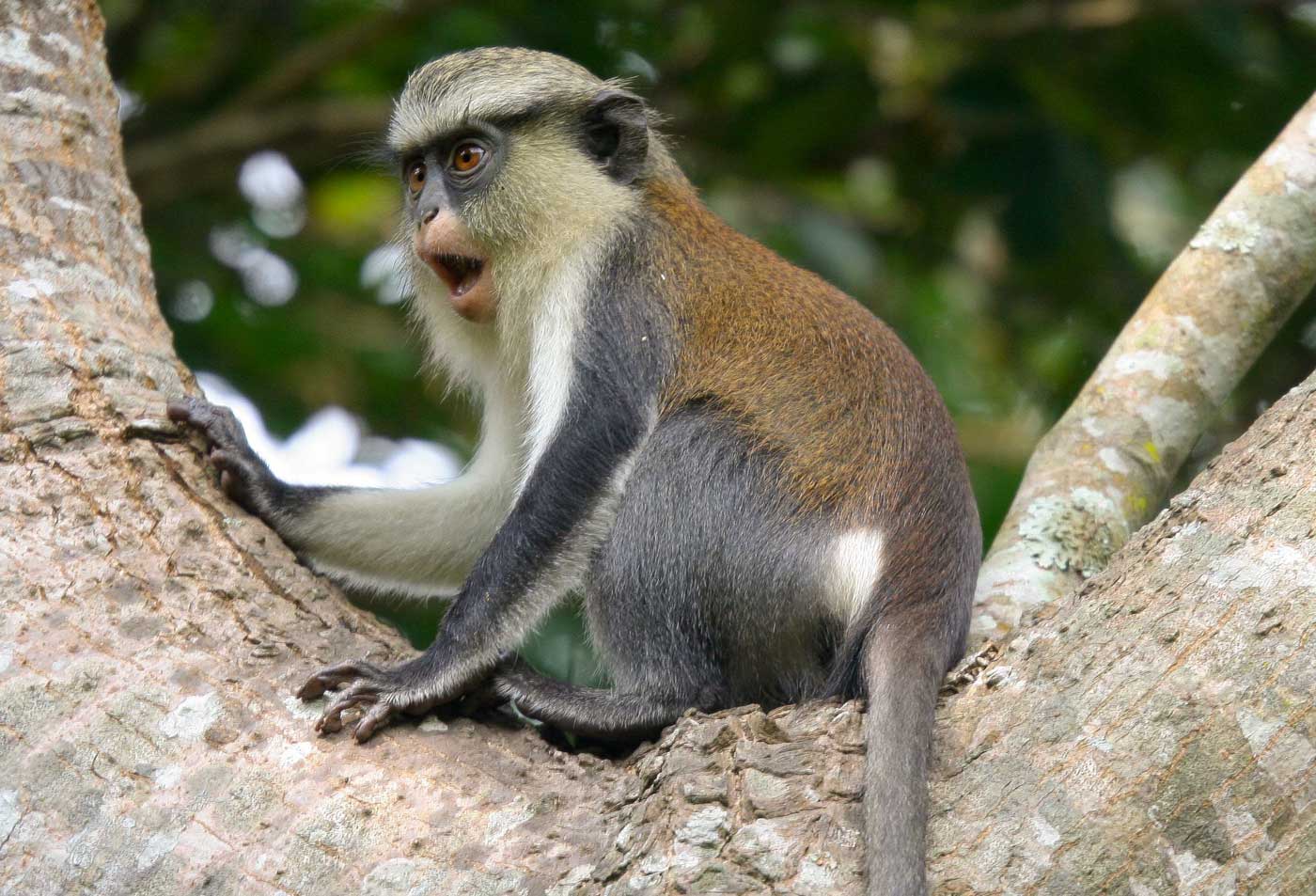
Ghana

Mona Monkey, Cercopithecus mona
I had never been to West Africa so when I had to visit Ghana for work in December 2007 I was keen to hit the forest. But the trip was sandwiched between two others, so I had precious little time. From reading various trip reports and talking to local operators, my expectations were low. I used a guide called Elike to arrange the trip. I suppose there might be worse guides in the world. I haven’t met them. Luckily he hired a good driver, and the guide in Kakum – Robert Ntakor- was superb.
Shai Hills
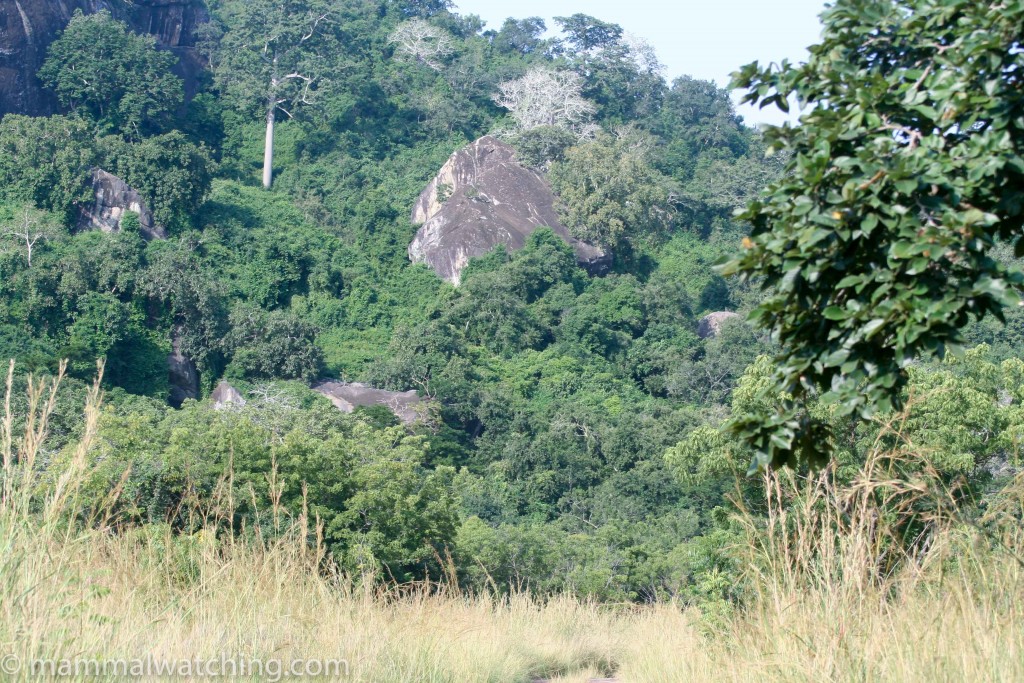
Shai Hills Reserve
Shai Hills Resource Reserve is about an hour’s drive from Accra (or more if the traffic is bad which it usually is). I spent a few hours here. The park is part scattered woodland with pockets of rainforest on the hills.
Olive Baboons are common and so, in theory are Uganda Kob, though in December the grass was very long and it took some time to track a couple down. We heard a couple of Green Monkeys (though piossibly these were Tantalus Monkeys) calling and the guide saw one but I couldn’t get onto it which was frustrating in an African way. The Monkeys were one the edge of a patch of rainforest near the bat cave.
Me – “Where are the Monkeys?”.
Ranger – “On top of the tree”.
Me – “Which tree?”
Ranger – “The tree with the green leaves.”
Me – “They all have green leaves.”
Ranger – “The fourth tree. One, two, three, four.” (accompanied by random pointing)
Me – “How far away?”
Ranger – “5 metres…. No 50… I mean two kilometres”
By now the monkeys had gone.
There are a couple of bat caves in the park. I visited one, which was easily accessible, and there were several hundred Egyptian Tomb Bats inside (not Mauritian Tomb Bats which these are often misidentified as here).
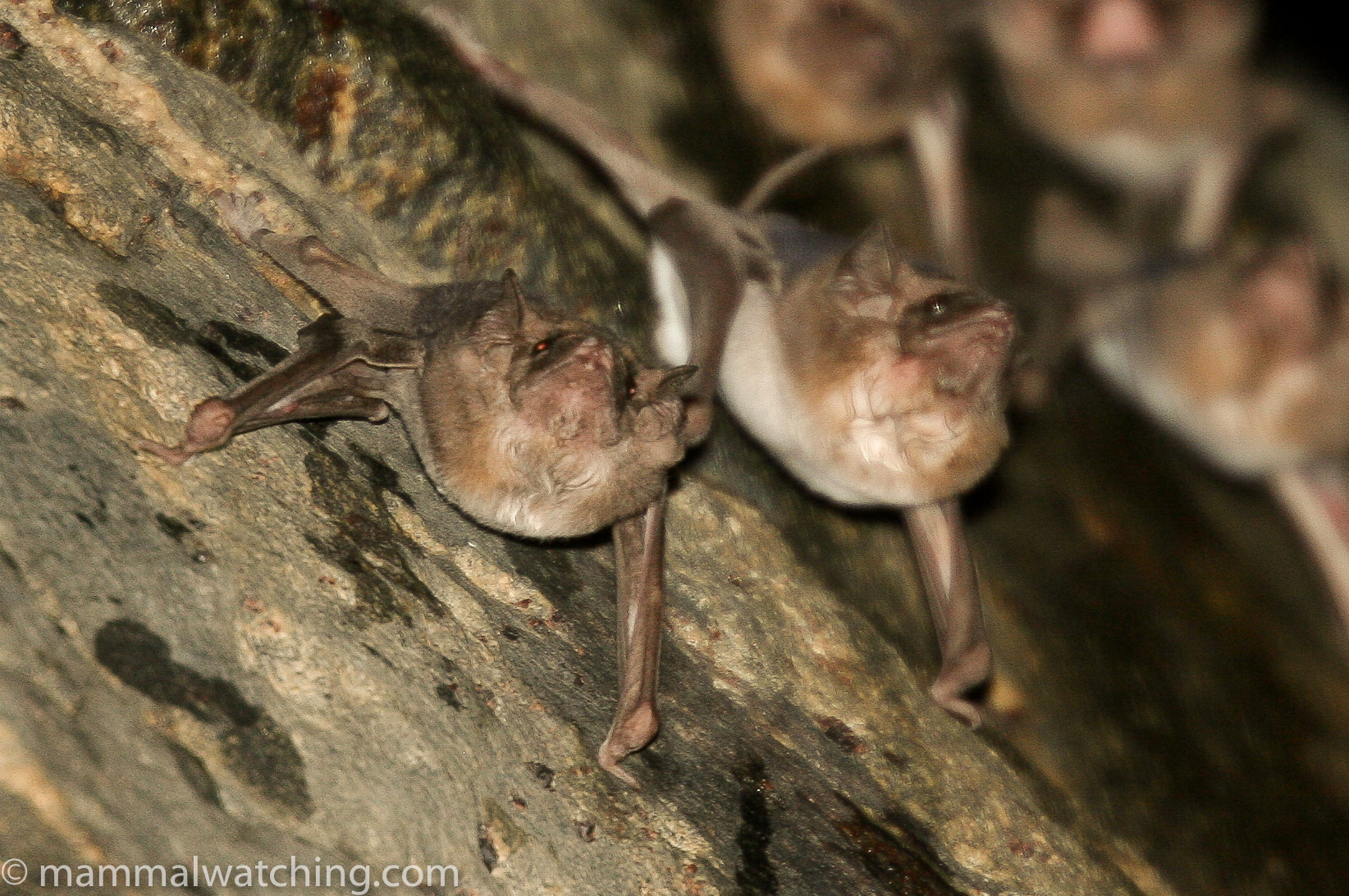
Egyptian Tomb Bat, Taphozous perforatus
The other cave, which I didn’t visit, apparently had Egyptian Rousettus.
There are a few Lesser Spot-nosed Monkeys in the park though they are rare. Marsh Cane Rats (called Grasscutters by the locals) are seen occasionally though are mainly active at night and the park is only open from 6am to 5pm.
Tafi Atome Monkey Sanctuary
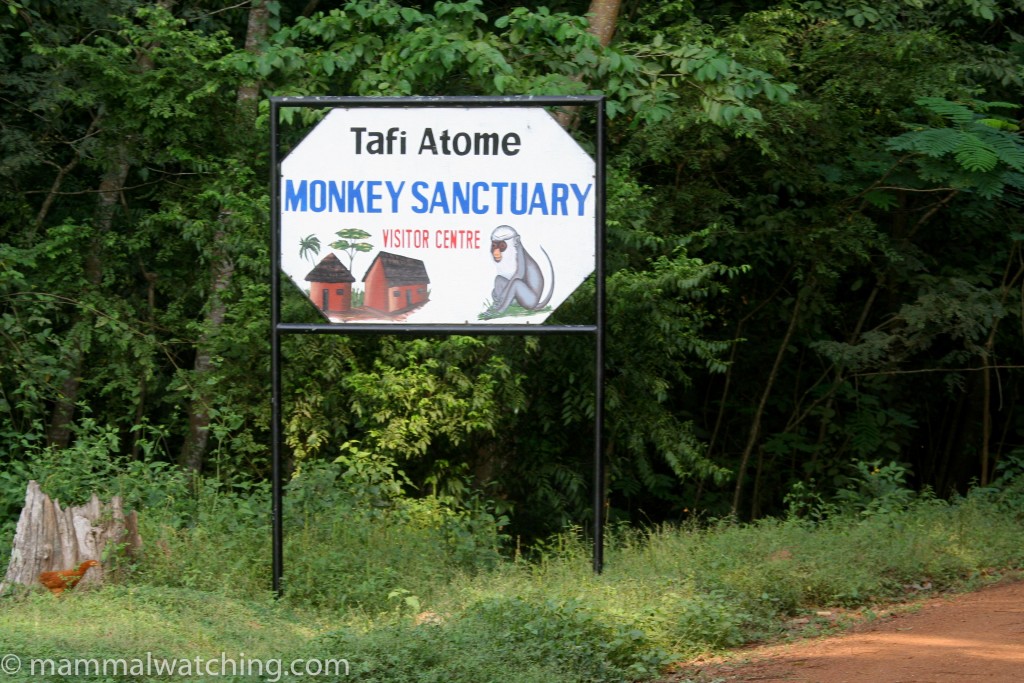
Ghana has several community-based conservation projects, including at least two monkey sanctuaries. Both of these are villages around which the locals have protected the forest and its monkeys (often because the monkeys have some kind of sacred status). The monkeys, as a result, are very tame. The Tafi Atome Sanctuary is another 2.5 hours from Accra past Shai Hills. It is on the eastern side of the River Volta, so the Mona Monkeys here are ‘true’ Mona’s (Cercopithecus mona); those on the other side of the river are Lowe’s (Mona) Monkeys (Cercopithecus lowei).
An average of three sets of tourists visit each day and one of the villagers showed me around for a small fee, which included some bananas to feed the monkeys. We found a group of about 15 or so within five minutes. Beautiful things.
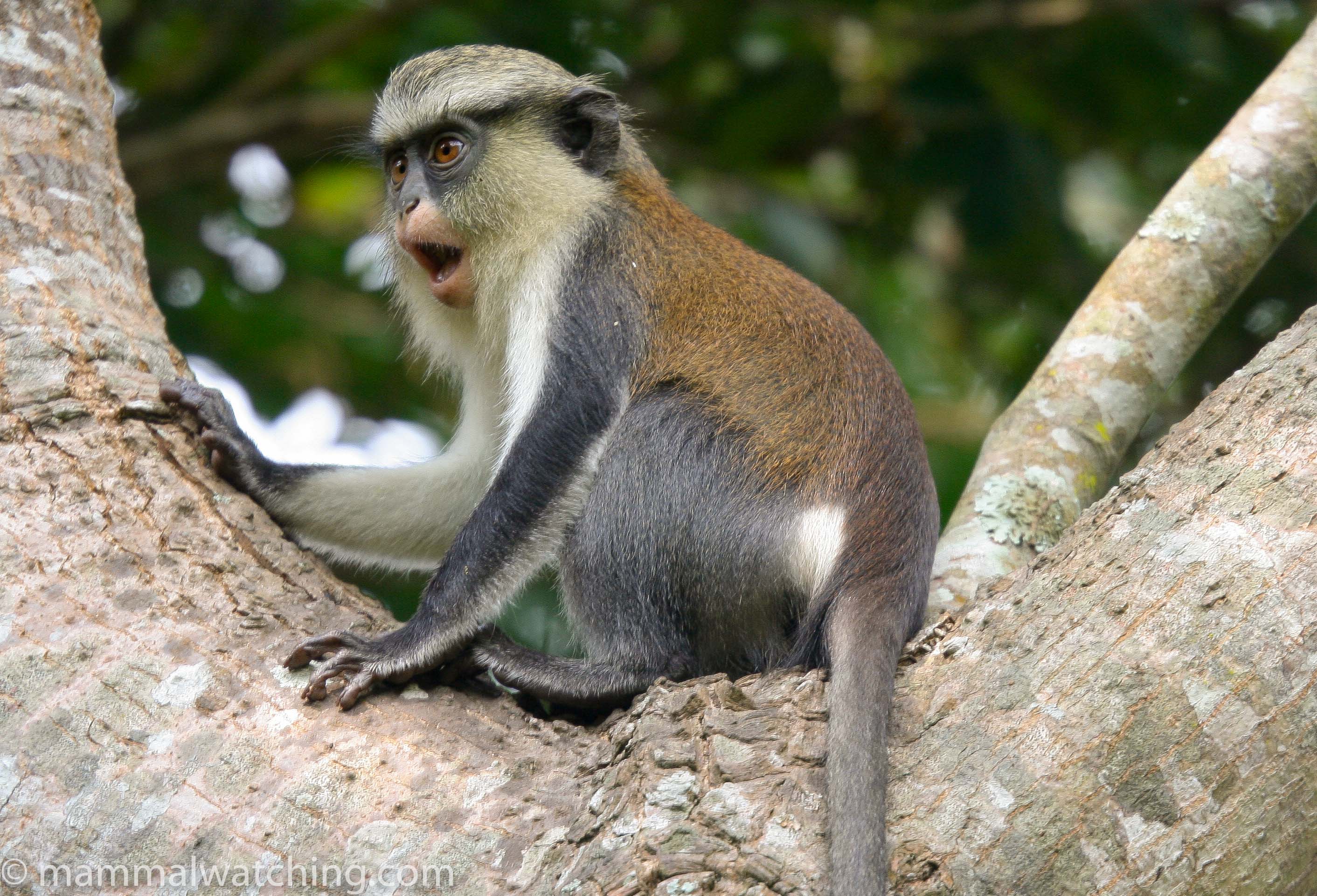
Mona Monkey,Cercopithecus mona. The white oval patch bordering the base of the tail is diagnostic.
There are a few other mammals in the forest. Squirrels are quite common, especially in the early morning when they feed in palm trees in the village. After an hour of looking in the afternoon I saw a Red-legged Sun Squirrel and then a couple of squirrels, most probably a different species, run along a fallen tree. After considerable debate with the locals looking in my field guide, I gave up trying to work out which other species occurred in the forest, though it seems several do. The day before my visit, a Lord Derby’s Anomalure had been in a tree by the visitors’ office at 11am. Red River Hogs were also apparently findable but with a considerable amount of effort.
Kakum National Park
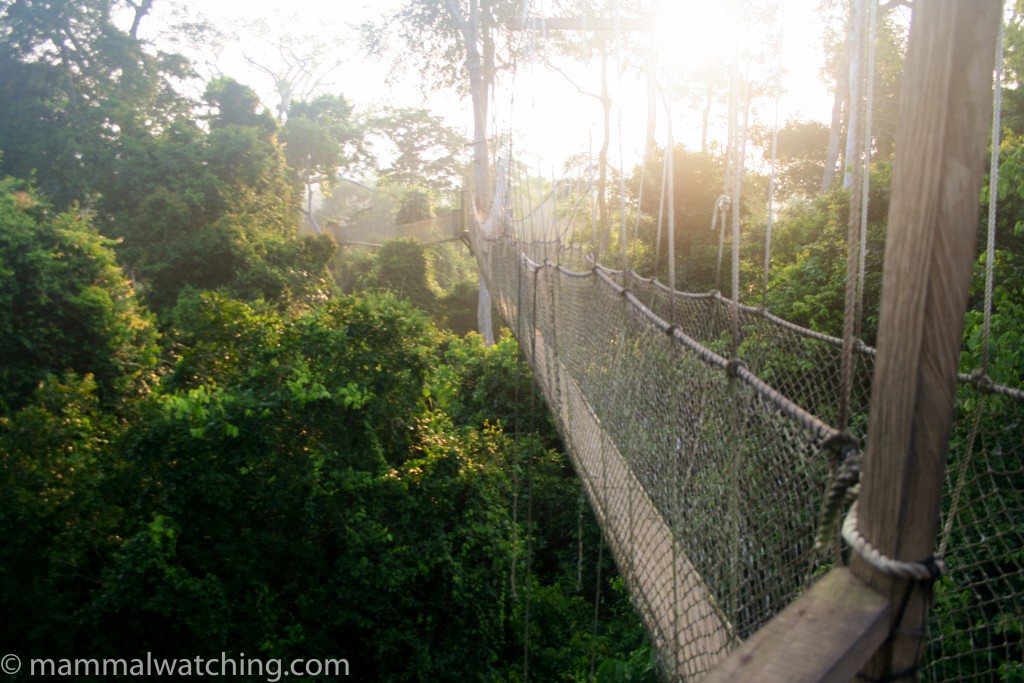
Canopy Walkway, Kakum
Kakum National Park is about 40 minutes from the town of Cape Coast, which is about 3 hours south-west of Accra. It is a well known birding destination and although it is relatively small (357 square kilometres) it is one of the larger and better protected tracts of rainforest left in the region. It also has an excellent canopy walkway, one of the best I have been on anywhere.
One of the park guides, Robert Ntakor, showed me around. He was truly excellent and seemed to know a great deal about the birds. But he was also had a genus for finding mammals.
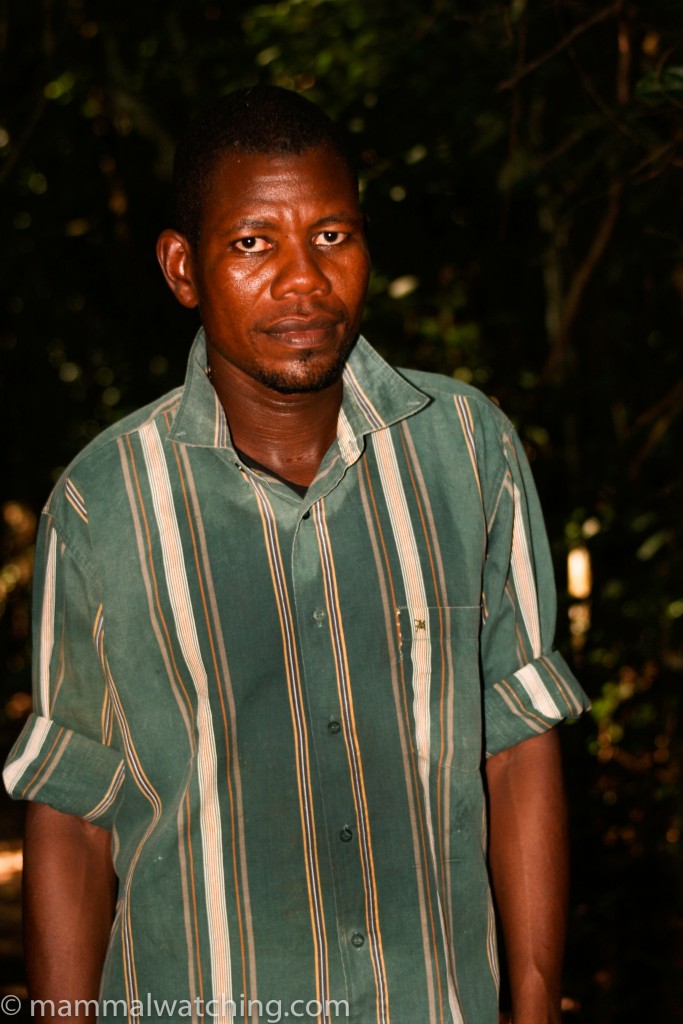
Robert Ntakor: Pangolin finder extraordinarire.
Although Kakum opens at 8am and closes at 5pm, it is possible to come and go as you please if you arrange a guide. There is also a newly opened and quite basic lodge inside the park as well as a campsite. Both options are close to the main HQ and the canopy walkway.
There are a couple of trails too that wander through the forest, although the forest is quite open and with a guide you can go where you want off trail. Ants were a problem: they are small, they swarm up your legs and they bite. There are apparently other ways into different bits of the park but to get there we needed a high clearance vehicle.
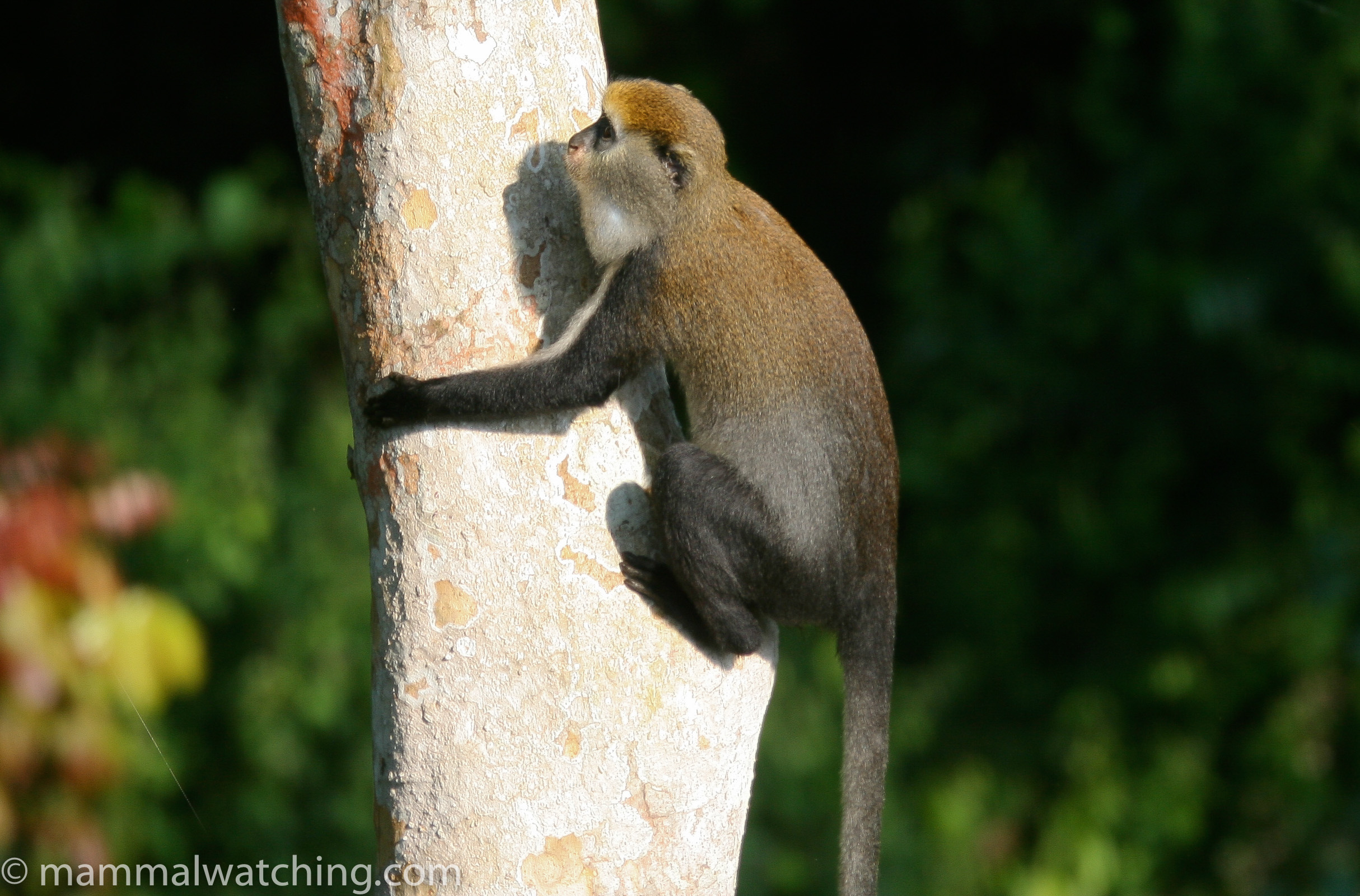
Lowe’s Monkey, Cercopithecus lowei
There are 5 species of monkeys in the park. Lowe’s Monkeys, Lesser Spot-nosed Monkeys and Olive Colobus are all quite common and easy to spot. A large mixed troop hangs around the walkway and usually move past it early in the morning. Robert said that the Lowe’s Monkeys usually led the way, traveling at mid-canopy level. They were followed by the Spot-Noseds (a bit higher in the trees) with the Olive Colobuses bringing up the rear and traveling lower down. And sure enough that is what happened.
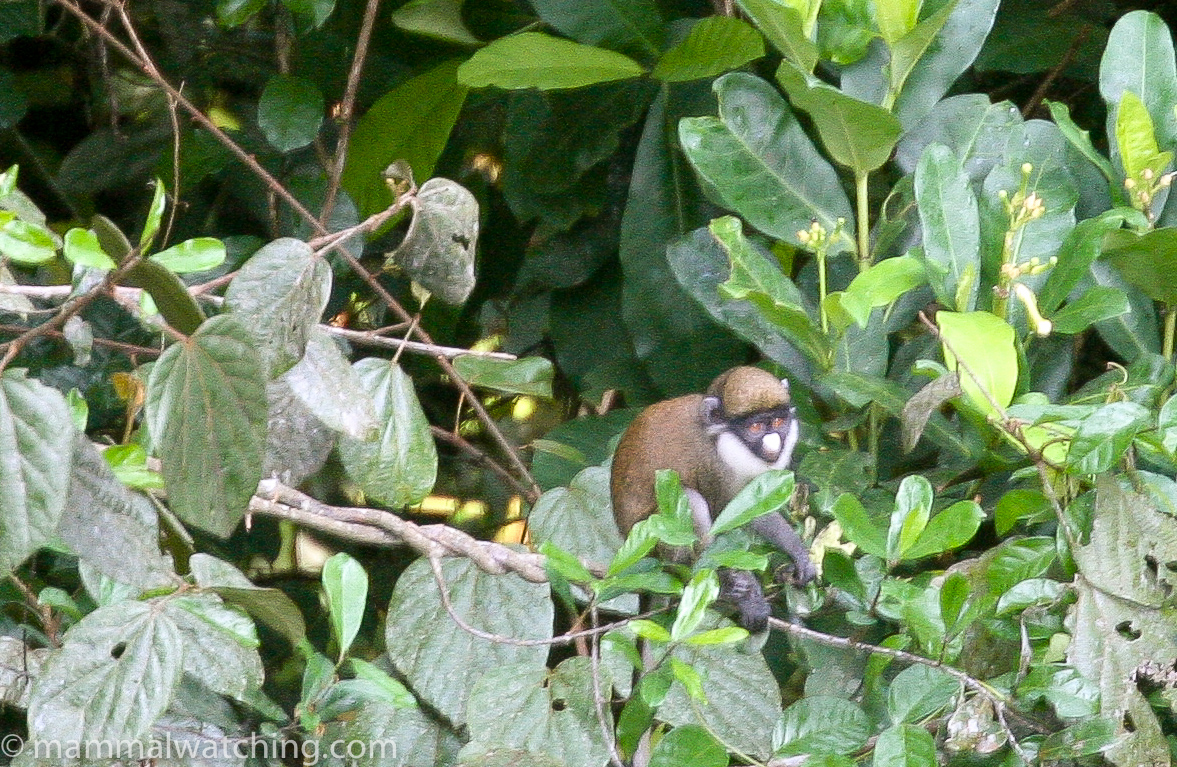
Lesser Spot-nosed Monkey, Cercopithecus petaurista
We heard all three species on several other occasions while walking in the forest. I didn’t see the two other species: Geoffroy’s Colobus are seen occasionally from the walkway (and indeed we heard them quite close to the HQ in the late morning); Diana Monkeys are rare and/or hard to find.
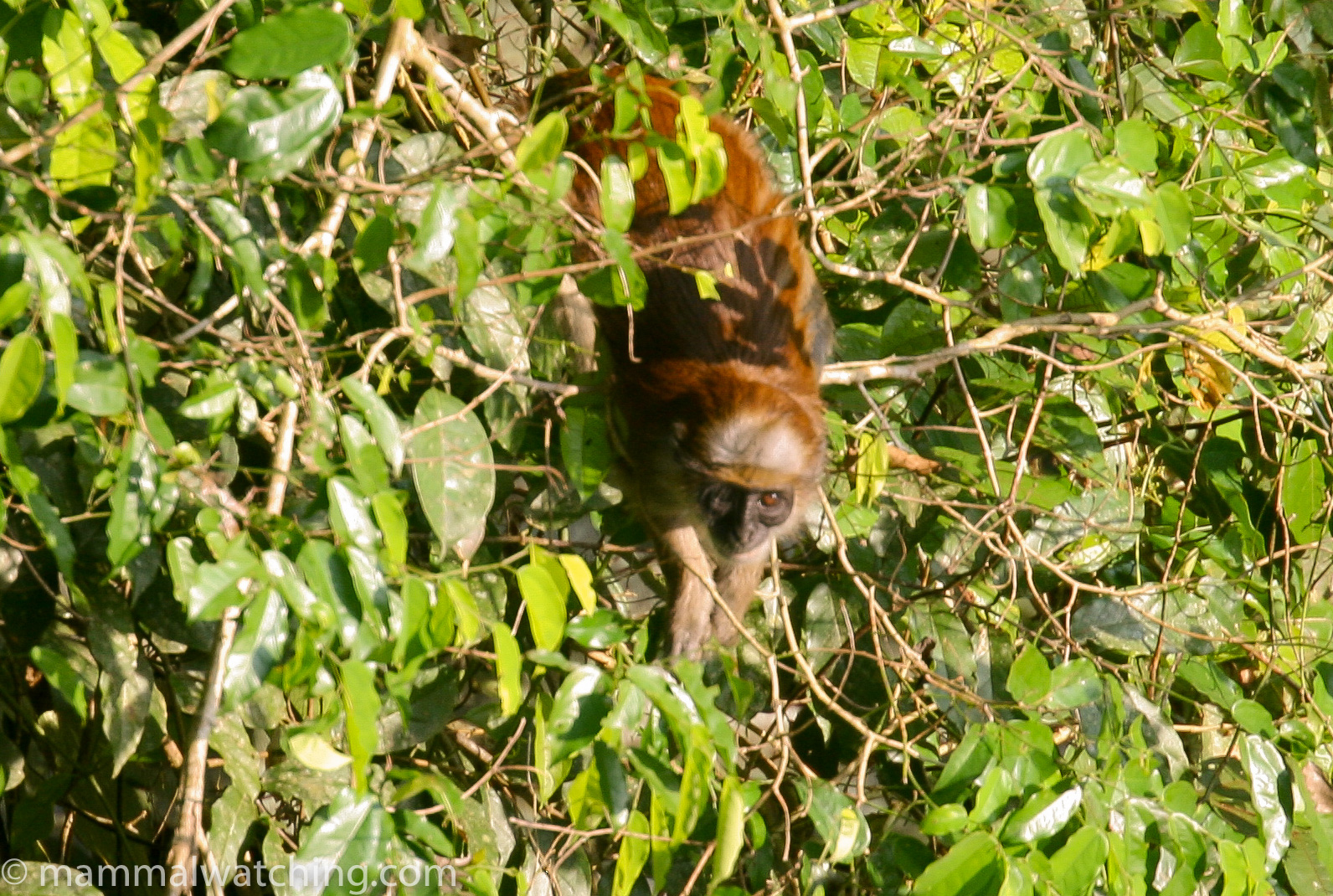
Olive Colobus, Procolobus verus
Coming down from the canopy and walking the Ebony Trail we saw about 5 or 6 Long-nosed Cusimanse scurry across the path.
A two hour spotlight walk with Robert was quite disappointing. We heard the Olive Colobuses at dusk, and also plenty of Western Tree Hyraxes and a couple of Demidoff’s Galagos (these might have been Thomas’s Galagos, but they were low down and in disturbed forest so Demidoff’s are more likely). But the only mammals we saw were a pair of African Dormice zipping around in a tree. I think these were probably Nagtgla’s Dormice. I saw them on and off for a couple of minutes and they were quite close but they wouldn’t sit still (the only other possibility might have been Lorraine’s Dormouse but these seem less common in primary forest and also much smaller). Robert was quite surprised we didn’t see more: Maxwell’s Duikers and African Palm Civets were two species that he said we quite common.
I went spotlighting again one evening after an afternoon of heavy rain. I couldn’t see anything from the vehicle when we drove the kilometre or two along the highway that borders the park but I got great views of my first Potto in a fork in a tree on the edge of the car park at the visitor centre. After 20 minutes in the spotlight it moved off with a breathtaking slowness that I have not seen matched by anything other than bar staff in most Paris pubs when they you are trying to attract their attention.
I saw another later that night along the short trail to the campsite and before dawn I saw a Demidoff’s Galago along the same trail. You aren’t allowed to enter the forest without a guide and given the number of gunshots we heard coming from the forest (presumably poachers) it might not be a good idea.
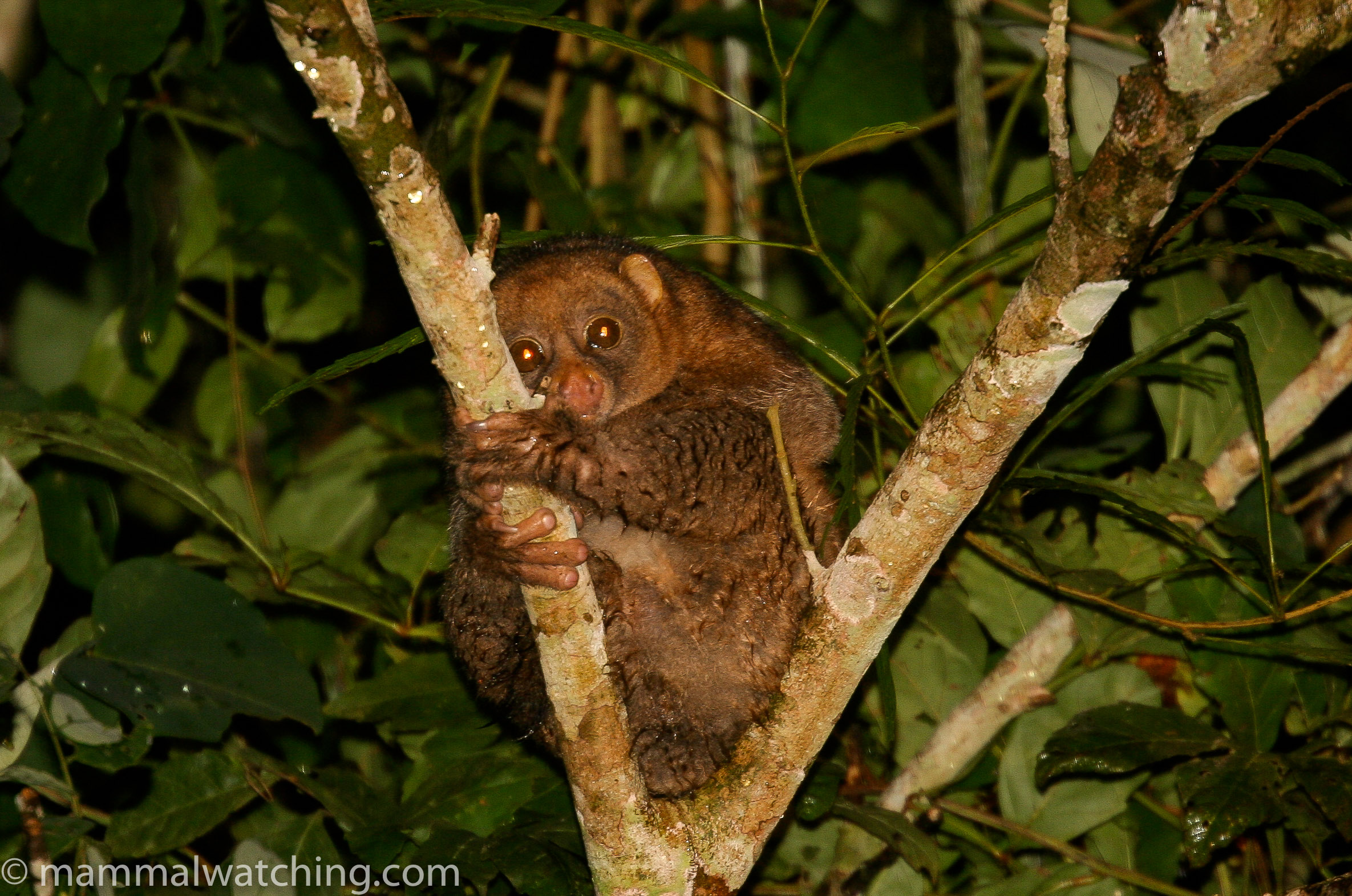
Potto, Perodicticus potto
I spent a long morning walking through the forest with Robert. Again it was fairly quiet. We saw a Green Squirrel or two, and a Red-legged Sun Squirrel. We heard a Giant Squirrel along with another squirrel that, from Robert’s description, was presumably a Fire-footed Rope Squirrel. We also another Cusimanse, saw Lowe’s Monkeys and heard Geoffroy’s Pied Colobus quite near to the visitor centre in the late morning. At about 10am something bolted through the undergrowth close to where we stood. Robert saw it better than me and identified it as a Brush-tailed Porcupine. All I saw was a blur of brown that, even I, with my dodgy ethics for counting new mammals, couldn’t in all conscience add to my life list.
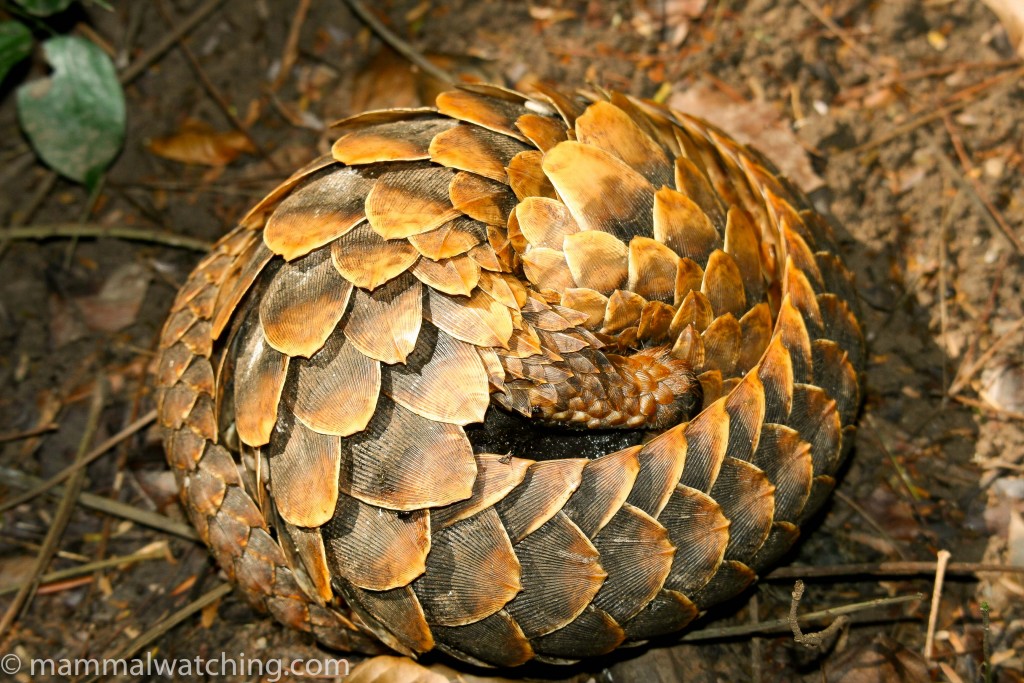
Long-tailed Pangolin, Uromanis tetradactyla
At about 1pm, just back on the main trail we stopped to look for a squirrel that Robert had seen. While scanning the bushes he got a glimpse of movement and saw about 2cm of something brown sticking out of a thicket. This turned into a Long-tailed Pangolin. Even when I could see the tail through the binoculars (all we could see was the size and texture of a pine cone) I still wasn’t convinced that it wasn’t just a couple of strange leaves. And so I have simply no idea how Robert spotted it.
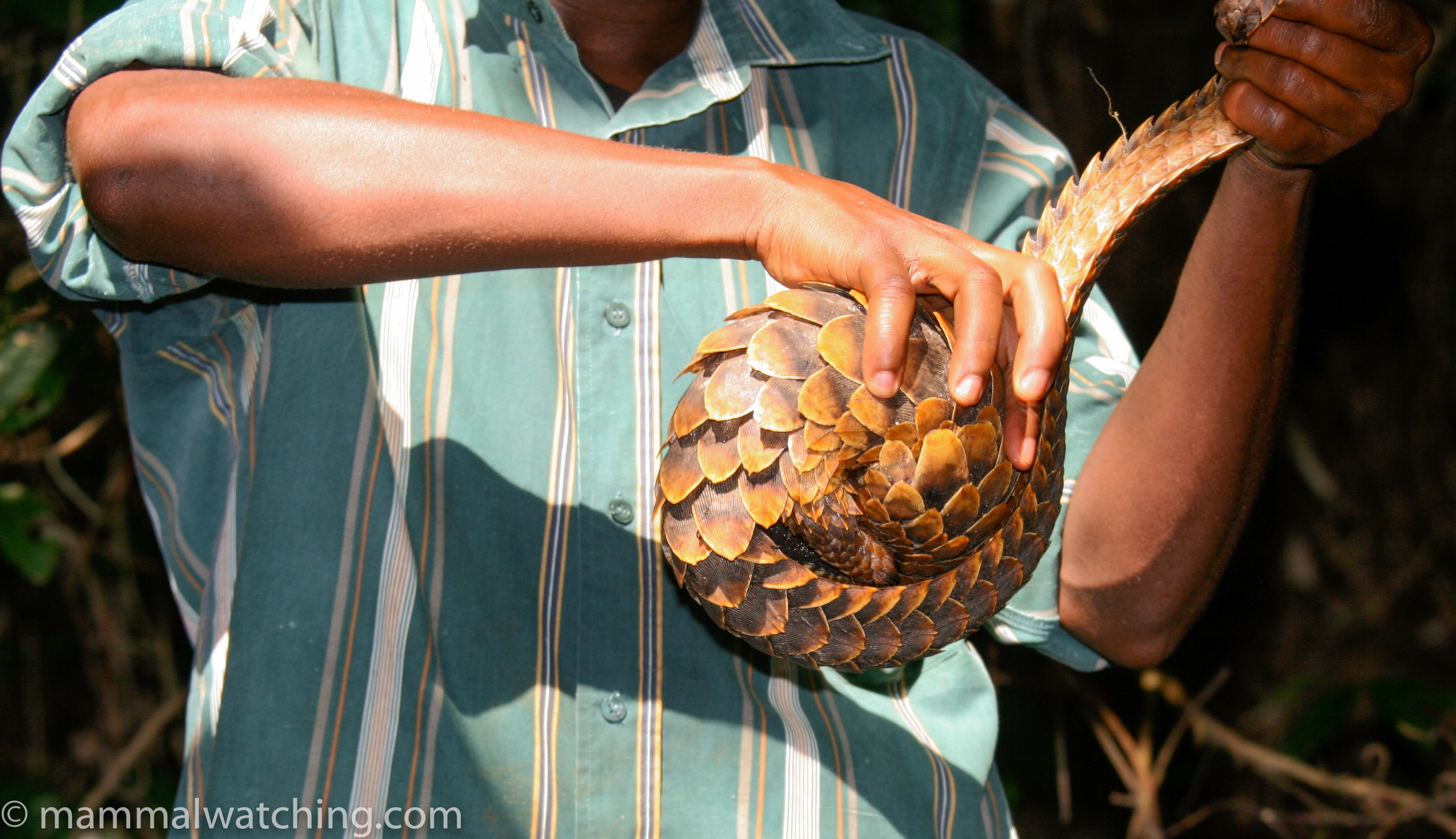
Long-tailed Pangolin, Uromanis tetradactyla
The day before I had been telling him about my longing to see a Pangolin and so he insisted on climbing the tree to catch the beast. I didn’t object. Although Pangolins are rather more common here than further south there was still considerable excitement with the staff from the Park cafe coming up to look at it. A fascinating animal, my 150th lifer of the year and one of my favourite animals of all time (and also one of the strangest).
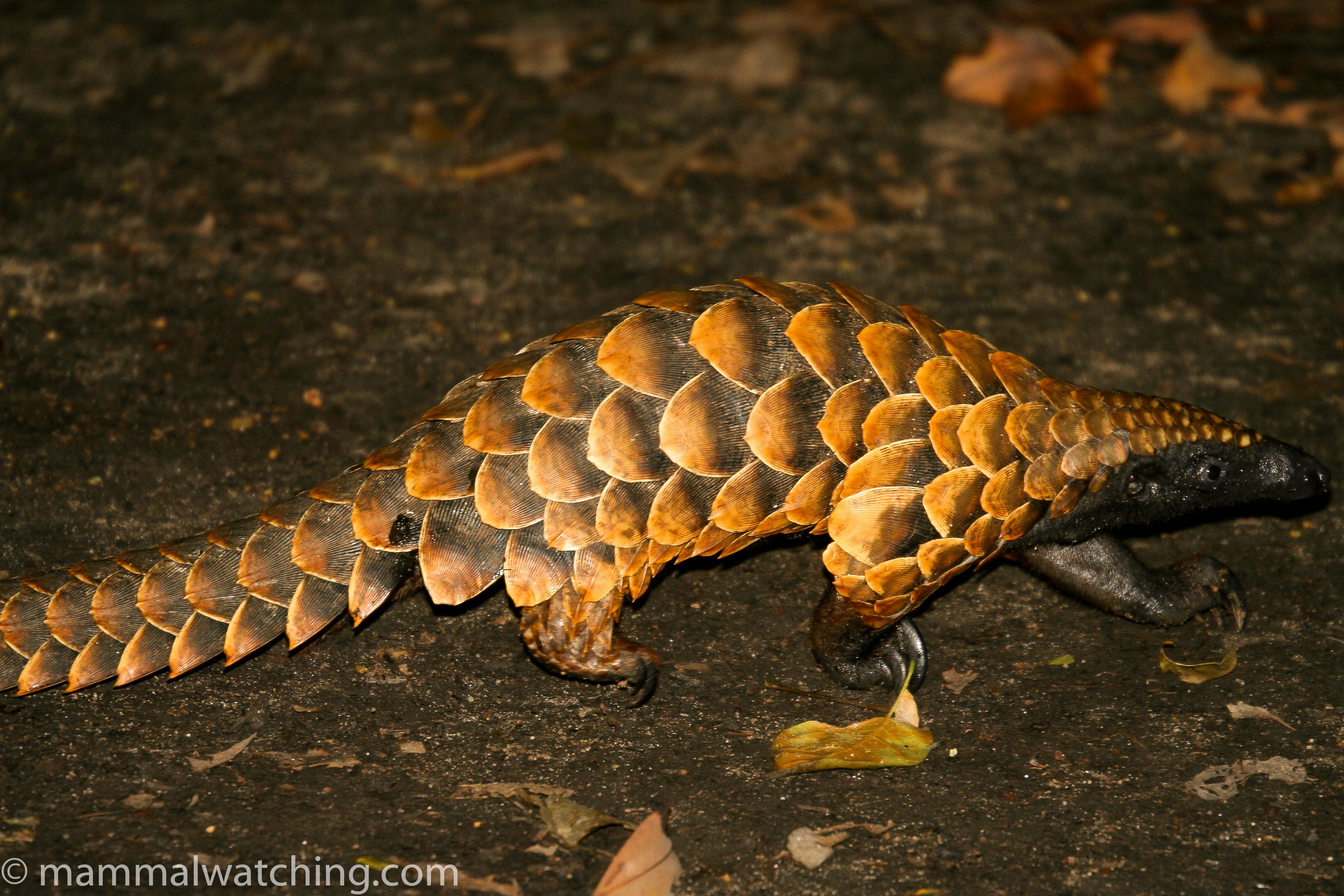
Long-tailed Pangolin, Uromanis tetradactyla
On the drive back to Ghana there was evidence of a thriving bush-meat trade, mainly in Marsh Cane Rats, something of a local delicacy: fresh ones were going for about $50! They were also available as take-out. Finally, Straw-coloured Fruit Bats are very common in Accra with a large colony near a military base called “39”.
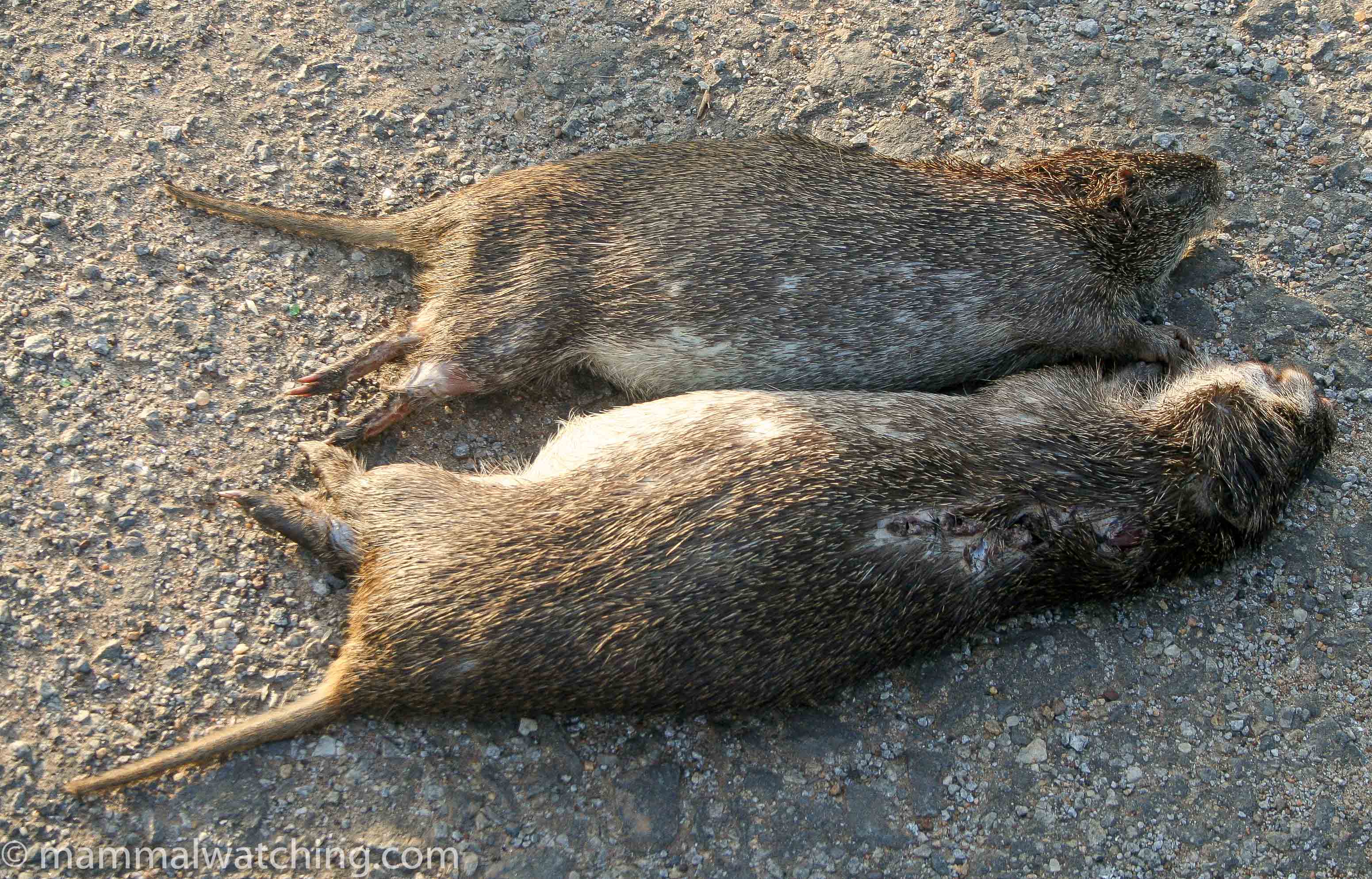
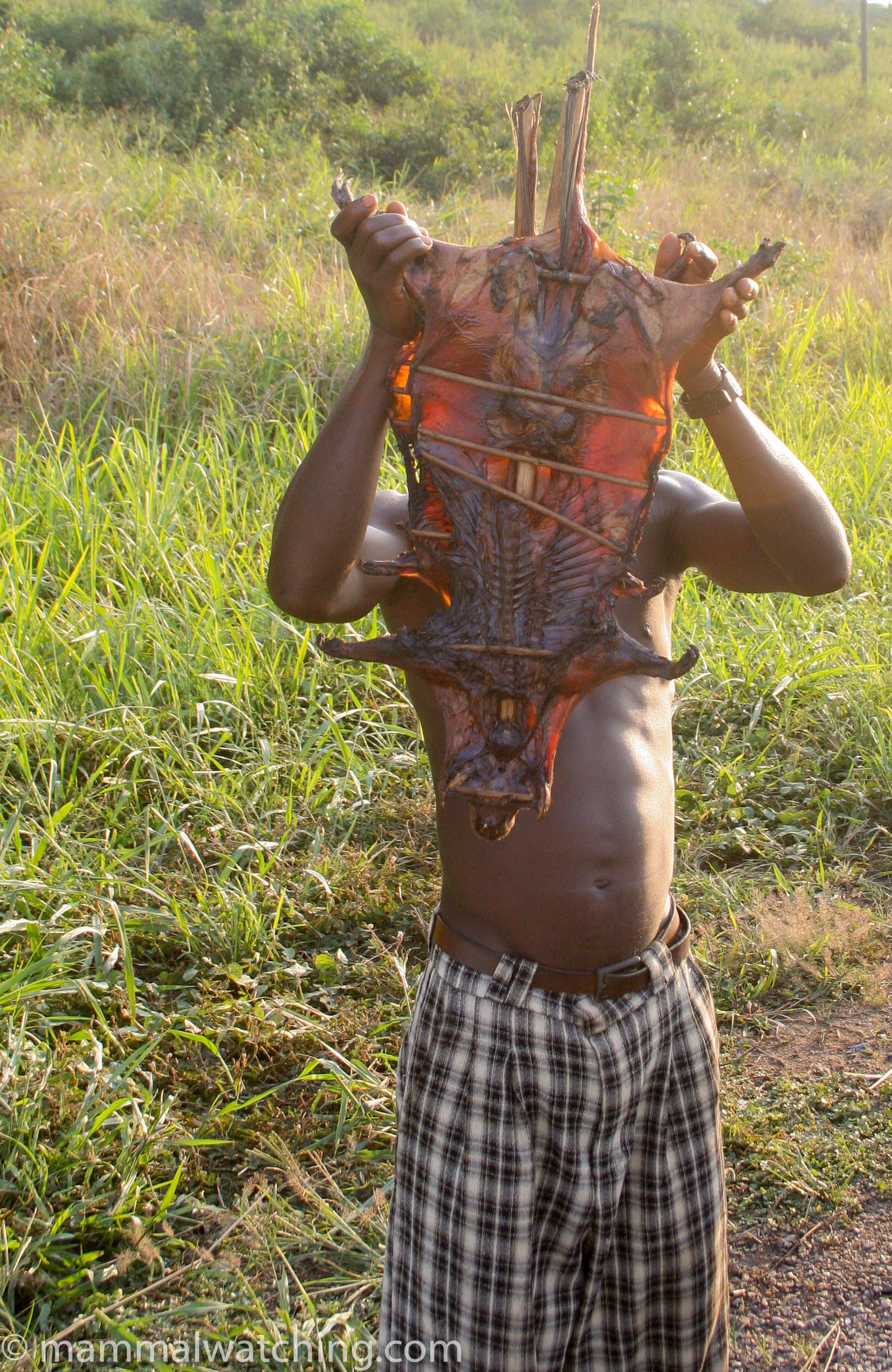
Fresh and Fried Grasscutters (Marsh Cane Rats))
Stuff I Missed
Kakum gives up its mammals only slowly and is now high on my list of places to return too. According to Robert, and I have no reason to doubt him, Maxwell’s Duikers are quite common with Bay, Black and Yellow-backed Duikers around deeper in the forest. Forest Elephants are seen occasionally (apparently easier to see when there is heavy poaching activity when they move nearer to the HQ) as are Giant Pangolins and Giant Forest Hogs. Bongos are present but notoriously difficult to find. Ditto Diana Monkeys. There are several other species of squirrels there including Slender-tailed Squirrels and Western Palm Squirrels (I guess the canopy walkway is the best place to look for them). African Palm Civets, Tree Hyraxes, and Brush-tailed Porcupines are all quite common. So an impressive set of species.
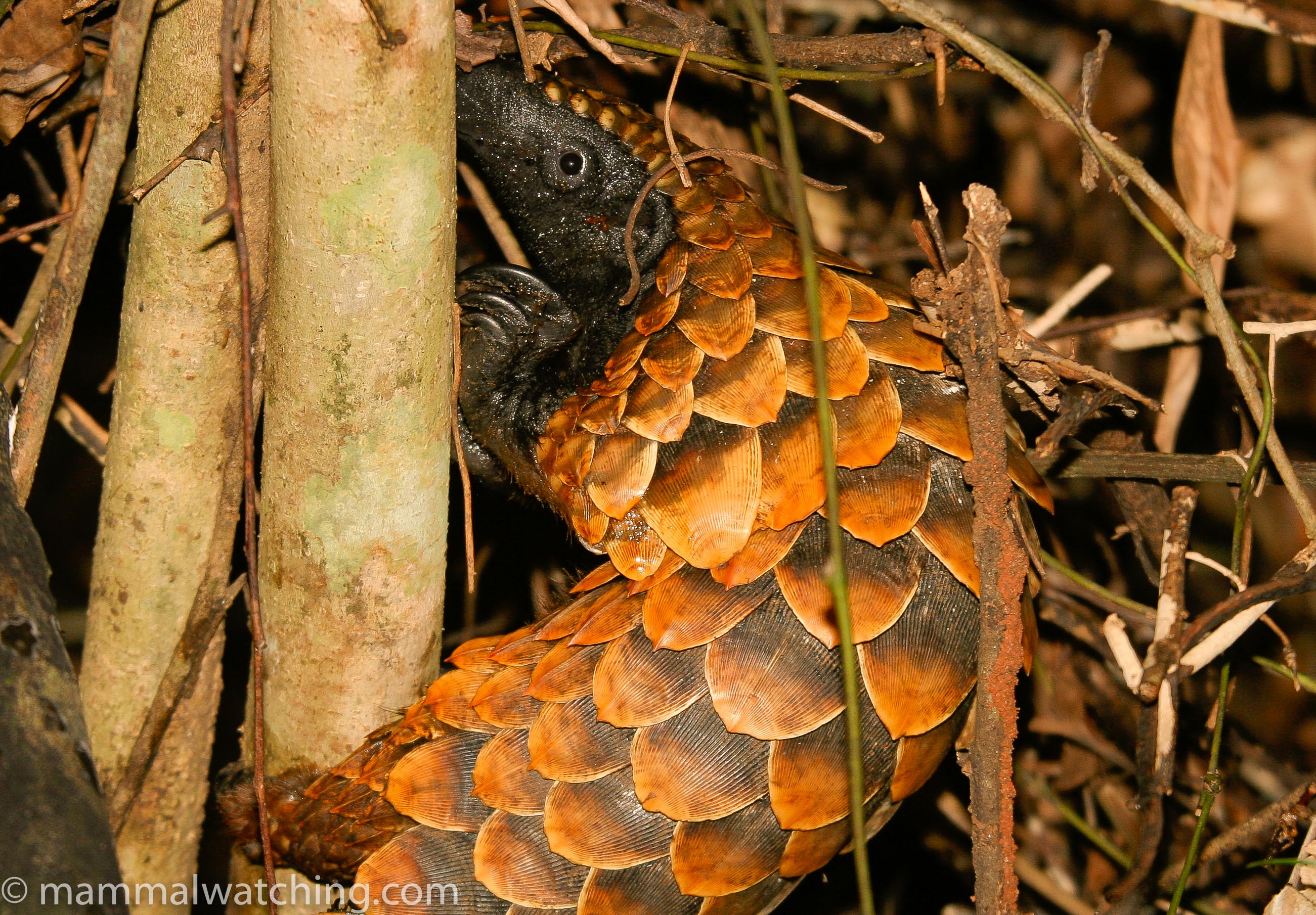
Long-tailed Pangolin, Uromanis tetradactyla
Places I Missed
Another notable site for Ghanaian mammal watching is Mole National Park. En-route from Accra you can stop at the Boabeng Fiema Monkey Sanctuary where one of the Mona superspecies (I suppose Lowe’s though one website said they were Campbell’s Monkeys) and Geoffroy’s Colobus are common. Mole itself has Patas Monkey (common) and Red-flanked Duikers (often reported) along with Elephants, and commoner stuff. Senegal Galagos, Four-toed Hedgehogs, Yellow and Hammer Bats have also been reported from there by birdwatchers. Steve Davis (see his 2010 report below) went to Ankasa which also sounds very good.
Trip List
1. Red-legged Sun Squirrel Heliosciurus rufobrachium
2. Forest Giant Squirrel Protoxerus stangeri (heard only)
3. Green Bush Squirrel Paraxerus poensis
4. Fire-footed Rope Squirrel Funisciurus pyrropus (heard only)
5. Nagtgla’s Dormouse Graphiurus nagtglasii
6. Brush-tailed Porcupine Atherus africanus
7. Long-tailed Pangolin Uromanis tetradactyla
8. Long-nosed (Common) Cusimanse Crossarchus obscurus
9. Straw-colored Fruit Bat Eidolon helvum
10. Egyptian Tomb Bat Taphozous perforatus
11. Demidoff’s Galago Galago demidoff
12. Potto Perodicticus potto
13. Geoffroy’s Colobus Colobus vellerosus (heard only)
14. Olive Colobus Procolobus verus
15. Olive Baboon Papio anubis
16. Lowe’s Monkey Cercopithecus lowei
17. Mona Monkey Cercopithecus mona
18. Lesser Spot-nosed Monkey Cercopithecus petaurista
19. Green Monkey Chlorocebus sabaeus (heard only)
20. Kob Kobus kob
21. Western Tree Hyrax Dendrohyrax dorsalis (heard only)
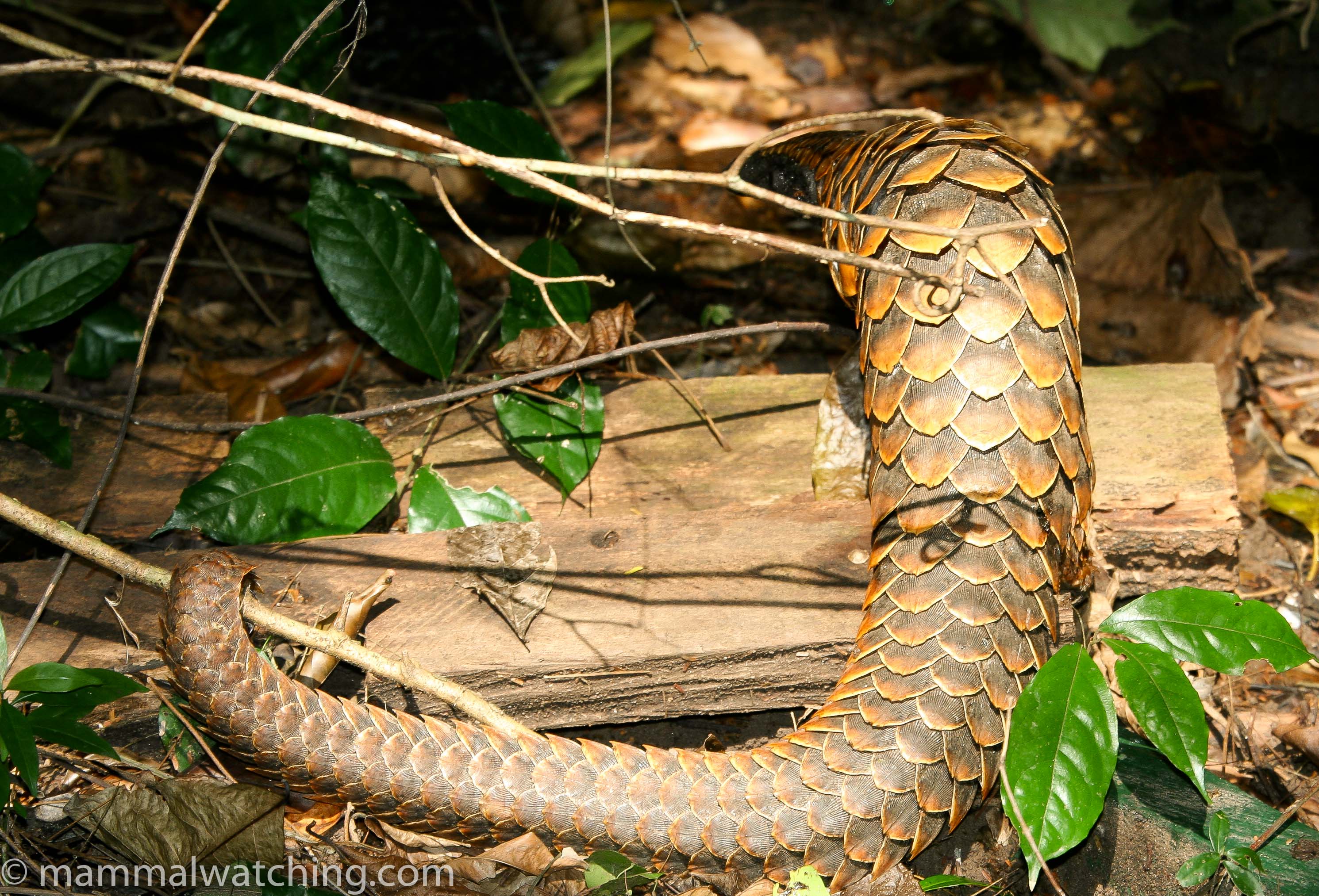
Long-tailed Pangolin, Uromanis tetradactyla
Community Reports
The World’s Best Mammalwatching
Robert Ntakor was my guide when I visited Ghana in 2007 and went to Kakum National Park. One of the finest guides I have come across, not least because he found me my first pangolin. I still do not understand how Robert managed to spot what was just a single scale pangolin peeping through the foliage. Legend! Robert now runs his own tour company (mainly birds but also mammals) and here’s his personal email. Ghana is still one of the best places in the world to look for both White and Black-bellied Pangolins. See more of the World’s Best Mammalwatching.
Ghana, 2024: Royle Safaris, 2 weeks & 25 species including Pel’s Anomalure, White-thighed Colobus and White-bellied Pangolin.
Ghana, 2024: Samiuel Marlin, 15 days & 37 species including Red-flanked Duiker, Pel’s Anomalure and two Long-tailed Pangolins.
Batting in Ghana, 2024: Carlos Bocos’s records of 13 bats he found during 2 weeks in Ghana including Hammer-headed Fruit Bats and a White-bellied Yellow Bat.
Ghana, 2023: Jan Ebr, 3 weeks of independent travel & 37 species including Red-flanked Duiker and Benin Tree Hyrax.
Ghana, 2023: Tobi Lundqvist, 9 days & 22 species including 2 Black-bellied Pangolin, Pel’s Anomalure and White-thighed Colobus.
Ghana, 2023: John Pilgrim & Ian prentice, 15 days & 31 species including Black and Red-flanked Duikers, Pel’s Anomalure and Common Cusimanse.
Ghana, 2021: Daan Drukker, 2 weeks & 41 species including Common Cusimanse, Gambian Mongoose, Pardine Genet, Pel’s Anomalure and Patas Monkey.
Ghana, 2019: Ben Chapple, 2 weeks & 30 species including Slender-tailed Squirrel, Pel’s Anomalure and Black-bellied Pangolin.
Ghana, 2019: Rauno Väisänen, 2 weeks & 46 species including Tree Pangolin, 3 anomlaure species, Hausa Genet, White-belllied Hedgehog and Patas Monkey.
Ghana 2018: Ian Thompson, 10 days & 34 species including Long-tailed and White-bellied Pangolins, Western Tree Hyrax, Flying Calf, African Palm Civet and Pel’s and Beecroft’s Anomalures.
Ghana, 2017: Romain Bocquier, 7 days & 28 species including a range of nice bats (including a Hammer Bat), Pel’s Anomalure, Olive Colobus, African Palm Civet and a Slender-tailed Squirrel. Further discussion on the Bat IDs is here.
Ghana, 2010: Steve Davis, 2.5 weeks and 37 species including some unusual ones like Yellow-winged Bat, Hammer Headed Fruit Bat, Red-flanked Duiker, Lord Derby’s Anomalure and Common Cusimanse. I need to go back!
Ghana, 1999: Bob Berghaier, 1 week and some nice mammals including Yellow-backed, Maxwell’s and Bay Duikers.
Also See
RFI: what gear do I pack for Ghana? October 2023
Pardine or Common Genet, February 2023
ID Help: Anomalure and Pouched Rat, February 2023
Resources
1 Comment
Leave a Reply
You must be logged in to post a comment.


Amber Melhouse
Have always wanted to see this part of the world!